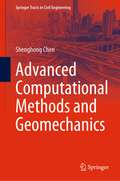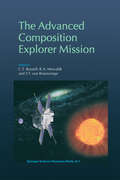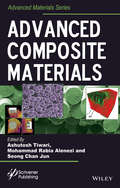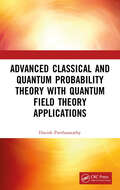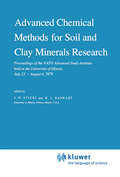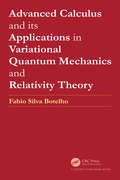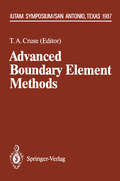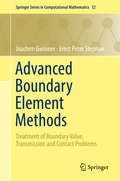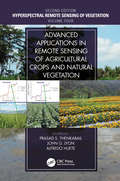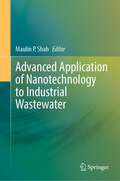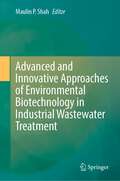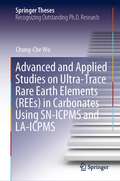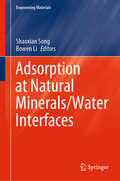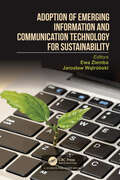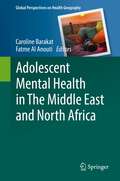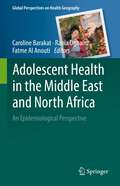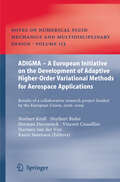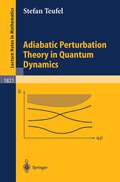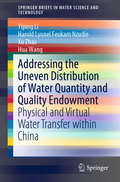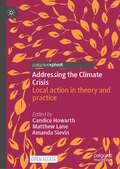- Table View
- List View
Advanced Computational Methods and Geomechanics (Springer Tracts in Civil Engineering)
by Shenghong ChenThe aim of this book is intended, through parallel expounding, to help readers comprehensively grasp the intrinsic features of typical advanced computational methods. These methods are created in recent three decades for the understanding of the post-failure of geo-materials accompanied with discontinuous and finite deformation/dislocation, as well as the violent fluid-structure interaction accompanied with strong distortion of water surface. The strong points and weak points of the formalisms for governing equations, the discretization schemes, the nodal interpolation /approximation of field variables, and their connectivity (via support domains, covers, or enrichments), the basic algorithms, etc., are clarified. Being aware of that the differences in these methods are not so large as at the first glance, this book will help readers to select appropriate methods, to improve the methods for their specific purpose, and to evaluate the reliability/applicability of the outcomes in the hazard evaluation of geotechnical (hydraulic) structures beyond extreme work situation. This book may be looked at as an advanced continuation of “Computational Geomechanics and Hydraulic Structures” by the author (2018) (Springer-Verlag, ISBN 978-981-10-8134-7) which elaborates the fundamental computational methods in geomechanics for the routine design of geotechnical (hydraulic) engineering.
The Advanced Composition Explorer Mission
by C. T. Russell R. A. Mewaldt T. T. Von RosenvingeNASA's Advanced Composition Explorer (ACE) was launched on August 25, 1997, carrying six high-resolution spectrometers that measure the abundances of the elements, isotopes, and ionic charge states of energetic nuclei in space. Data from these instruments is being used to measure and compare the composition of the solar corona, the nearby interstellar medium, and cosmic-ray sources in the Galaxy, and to study particle acceleration processes in a variety of environments. ACE also includes three instruments that monitor solar wind and energetic particle activity near the inner Lagrangian point, "1.5 million kilometers sunward of Earth, and provide continuous, real-time data to NOAA for use in forecasting space weather. Eleven of the articles in this volume review scientific progress and outline questions that ACE will address in solar, space-plasma, and cosmic-ray physics. Other articles describe the ACE spacecraft, the real-time solar-wind system, and the instruments used to measure energetic particle composition.
Advanced Composite Materials (Advanced Material Series)
by Ashutosh Tiwari Mohammad Rabia Alenezi Seong Chan JunComposites materials is basically the combining of unique properties of materials to have synergistic effects. A combination of materials is needed to adapt to certain properties for any application area. There is an everlasting desire to make composite materials stronger, lighter or more durable than traditional materials. Carbon materials are known to be attractive in composites because of their combination of chemical and physical properties. In the recent years, development of new composites has been influenced by precision green approaches that restrict hazardous substances and waste created during production. This book ranges from the fundamental principles underpinning the fabrication of different composite materials to their devices, for example, applications in energy harvesting, memory devices, electrochemical biosensing and other advanced composite-based biomedical applications. This book provides a compilation of innovative fabrication strategies and utilization methodologies which are frequently adopted in the advanced composite materials community with respect to developing appropriate composites to efficiently utilize macro and nanoscale features. The key topics are: Pioneer composite materials for printed electronics Current-limiting defects in superconductors High-tech ceramics materials Carbon nanomaterials for electrochemical biosensing Nanostructured ceramics and bioceramics for bone cancer Importance of biomaterials for bone regeneration Tuning hydroxyapatite particles Carbon nanotubes reinforced bioceramic composite Biomimetic prototype interface
Advanced Composite Materials (Advanced Material Series)
by Ashutosh Tiwari Mohammad Rabia Alenezi Seong Chan JunComposites materials is basically the combining of unique properties of materials to have synergistic effects. A combination of materials is needed to adapt to certain properties for any application area. There is an everlasting desire to make composite materials stronger, lighter or more durable than traditional materials. Carbon materials are known to be attractive in composites because of their combination of chemical and physical properties. In the recent years, development of new composites has been influenced by precision green approaches that restrict hazardous substances and waste created during production. This book ranges from the fundamental principles underpinning the fabrication of different composite materials to their devices, for example, applications in energy harvesting, memory devices, electrochemical biosensing and other advanced composite-based biomedical applications. This book provides a compilation of innovative fabrication strategies and utilization methodologies which are frequently adopted in the advanced composite materials community with respect to developing appropriate composites to efficiently utilize macro and nanoscale features. The key topics are: Pioneer composite materials for printed electronics Current-limiting defects in superconductors High-tech ceramics materials Carbon nanomaterials for electrochemical biosensing Nanostructured ceramics and bioceramics for bone cancer Importance of biomaterials for bone regeneration Tuning hydroxyapatite particles Carbon nanotubes reinforced bioceramic composite Biomimetic prototype interface
Advanced Classical and Quantum Probability Theory with Quantum Field Theory Applications
by Harish ParthasarathyThis book is based on three undergraduate and postgraduate courses taught by the author on Matrix theory, Probability theory and Antenna theory over the past several years. It discusses Matrix theory, Probability theory and Antenna theory with solved problems. It will be useful to undergraduate and postgraduate students of Electronics and Communications Engineering. Print edition not for sale in South Asia (India, Sri Lanka, Nepal, Bangladesh, Pakistan and Bhutan).
Advanced Classical and Quantum Probability Theory with Quantum Field Theory Applications
by Harish ParthasarathyThis book is based on three undergraduate and postgraduate courses taught by the author on Matrix theory, Probability theory and Antenna theory over the past several years. It discusses Matrix theory, Probability theory and Antenna theory with solved problems. It will be useful to undergraduate and postgraduate students of Electronics and Communications Engineering. Print edition not for sale in South Asia (India, Sri Lanka, Nepal, Bangladesh, Pakistan and Bhutan).
Advanced Chemical Methods for Soil and Clay Minerals Research: Proceedings of the NATO Advanced Study Institute held at the University of Illinois, July 23 – August 4, 1979 (Nato Science Series C: #63)
by J. W. Stucki W. L. BanwartDuring the past few years there has been a marked increase in the use of advanced chemical methods in studies of soil and clay mineral systems, but only a relatively small number of soil and clay scientists have become intimately associ ated and acquainted with these new techniques. Perhaps the most important obstacles to technology transfer in this area are: 1) many soil and clay chemists have had insufficient opportunities to explore in depth the working principles of more recent spectroscopic developments, and therefore are unable to exploit the vast wealth of information that is available through the application of such ad vanced technology to soil chemical research; and 2) the necessary equipment gen erally is unavailable unless collaborative projects are undertaken with chemists and physicists who already have the instruments. The objective of the NATO Advanced Study Institute held at the University of Illinois from July 23 to August 4, 1979, was to partially alleviate these obstacles. This volume, which is an extensively edited and reviewed version of the proceedings of that Advanced Study Institute, is an essential aspect of that purpose. Herein are summarized the theory and most current applications of six different spectroscopic methods to soil and/or clay mineral systems. The instrumental methods examined are Mossbauer, neutron scattering, x-ray photoelectron (XPS, ESCA), nuclear magnetic resonance (NMR), electron spin resonance (ESR, EPR), and photoacoustic spectroscopy. Contributing authors were also lecturers at the Advanced Study Institute, and are each well known and respected authorities in their respective disciplines.
Advanced Calculus and its Applications in Variational Quantum Mechanics and Relativity Theory
by Fabio Silva BotelhoThe first part of this book reviews some key topics on multi-variable advanced calculus. The approach presented includes detailed and rigorous studies on surfaces in Rn which comprises items such as differential forms and an abstract version of the Stokes Theorem in Rn. The conclusion section introduces readers to Riemannian geometry, which is used in the subsequent chapters. The second part reviews applications, specifically in variational quantum mechanics and relativity theory. Topics such as a variational formulation for the relativistic Klein-Gordon equation, the derivation of a variational formulation for relativistic mechanics firstly through (semi)-Riemannian geometry are covered. The second part has a more general context. It includes fundamentals of differential geometry. The later chapters describe a new interpretation for the Bohr atomic model through a semi-classical approach. The book concludes with a classical description of the radiating cavity model in quantum mechanics.
Advanced Calculus and its Applications in Variational Quantum Mechanics and Relativity Theory
by Fabio Silva BotelhoThe first part of this book reviews some key topics on multi-variable advanced calculus. The approach presented includes detailed and rigorous studies on surfaces in Rn which comprises items such as differential forms and an abstract version of the Stokes Theorem in Rn. The conclusion section introduces readers to Riemannian geometry, which is used in the subsequent chapters. The second part reviews applications, specifically in variational quantum mechanics and relativity theory. Topics such as a variational formulation for the relativistic Klein-Gordon equation, the derivation of a variational formulation for relativistic mechanics firstly through (semi)-Riemannian geometry are covered. The second part has a more general context. It includes fundamentals of differential geometry. The later chapters describe a new interpretation for the Bohr atomic model through a semi-classical approach. The book concludes with a classical description of the radiating cavity model in quantum mechanics.
Advanced Boundary Element Methods: Proceedings of the IUTAM Symposium, San Antonio, Texas, April 13–16, 1987 (IUTAM Symposia)
by Thomas A. CruseThe IUTAM Symposium on Advanced Boundary Element Methods brought together both established and current researchers in the broad context of applications of BEM technology. The goal of the Symposium was to provide both a formal and an informal forum for the interchange of ideas and the stimulation of new research directions.
Advanced Boundary Element Methods: Treatment of Boundary Value, Transmission and Contact Problems (Springer Series in Computational Mathematics #52)
by Ernst Peter Stephan Joachim GwinnerThis book is devoted to the mathematical analysis of the numerical solution of boundary integral equations treating boundary value, transmission and contact problems arising in elasticity, acoustic and electromagnetic scattering. It serves as the mathematical foundation of the boundary element methods (BEM) both for static and dynamic problems. The book presents a systematic approach to the variational methods for boundary integral equations including the treatment with variational inequalities for contact problems. It also features adaptive BEM, hp-version BEM, coupling of finite and boundary element methods – efficient computational tools that have become extremely popular in applications.Familiarizing readers with tools like Mellin transformation and pseudodifferential operators as well as convex and nonsmooth analysis for variational inequalities, it concisely presents efficient, state-of-the-art boundary element approximations and points to up-to-date research.The authors are well known for their fundamental work on boundary elements and related topics, and this book is a major contribution to the modern theory of the BEM (especially for error controlled adaptive methods and for unilateral contact and dynamic problems) and is a valuable resource for applied mathematicians, engineers, scientists and graduate students.
Advanced Applications in Remote Sensing of Agricultural Crops and Natural Vegetation
by Prasad S. Thenkabail John G. Lyon Alfredo HueteWritten by leading global experts, including pioneers in the field, the four-volume set on Hyperspectral Remote Sensing of Vegetation, Second Edition, reviews existing state-of-the-art knowledge, highlights advances made in different areas, and provides guidance for the appropriate use of hyperspectral data in the study and management of agricultural crops and natural vegetation. Volume IV, Advanced Applications in Remote Sensing of Agricultural Crops and Natural Vegetation discusses the use of hyperspectral or imaging spectroscopy data in numerous specific and advanced applications, such as forest management, precision farming, managing invasive species, and local to global land cover change detection. It emphasizes the importance of hyperspectral remote sensing tools for studying vegetation processes and functions as well as the appropriate use of hyperspectral data for vegetation management practices. The concluding chapter provides readers with useful guidance on the highlights and essence of Volume IV through the editors’ perspective. Key Features of Volume IV: Guides readers to harness the capabilities of the most recent advances in applying hyperspectral remote sensing technology to the study of terrestrial vegetation. Includes specific applications on agriculture, crop management practices, study of crop stress and diseases, crop characteristics based on inputs (e.g., nitrogen, irrigation), study of vegetation impacted by heavy metals, gross and net primary productivity studies, light use efficiency studies, crop water use and actual evapotranspiration studies, phenology monitoring, land use and land cover studies, global change studies, plant species detection, wetland and forest characterization and mapping, crop productivity and crop water productivity mapping, and modeling. Encompasses hyperspectral or imaging spectroscopy data in narrow wavebands used across visible, red-edge, near-infrared, far-infrared, shortwave infrared, and thermal portions of the spectrum. Explains the implementation of hyperspectral remote sensing data processing mechanisms in a standard, fast, and efficient manner for their applications. Discusses cloud computing to overcome hyperspectral remote sensing massive big data challenges. Provides hyperspectral analysis of rocky surfaces on the earth and other planetary systems.
Advanced Application of Nanotechnology to Industrial Wastewater
by Maulin P. ShahThis book discusses new and innovative trends and techniques in the application of nanotechnology to industrial wastewater treatment both at a laboratory scale and an industry scale, including treatment, remediation, sensing and pollution prevention. The book also explores unique physicochemical and surface properties of nanoparticles; it highlights advantages they provide for engineering applications. Each chapter covers a different nanotechnology-based approach and examines basic principles, practical applications, recent breakthroughs and associated limitations. Nanotechnology applications to wastewater research have significant impact in maintaining the long-term quality, availability and viability of water. Regardless of the origin—for example, municipal or industrial wastewater—the remediation nanotechnology allows water to be recycled and desalinized in addition to simultaneously detecting biological and chemical contamination. The book describes a broad area of nanotechnology and water research where membrane processes (nanofiltration, ultrafiltration, reverse osmosis and nanoreactive membranes) are considered key components of advanced water purification and desalination technologies that remove, reduce or neutralize water contaminants. Various nanoparticles and nanomaterials that could be used in water remediation (zeolites, carbon nanotubes, self-assembled monolayers on mesoporous supports, biopolymers, single-enzyme nanoparticles, zero-valent iron nanoparticles, bimetallic iron nanoparticles and nanoscale semiconductor photocatalysts) are also discussed. This book is beneficial for students and academicians to understand the recent research advancements in the field.
Advanced and Innovative Approaches of Environmental Biotechnology in Industrial Wastewater Treatment
by Maulin P. ShahThis book discusses new and innovative trends and techniques in the removal of toxic and refractory pollutants by means of various microbial biotechnology processes from wastewater, both on the laboratory and industrial scales. The book also highlights the main factors contributing to the removal of toxic pollutants as well as recycling, environmental impact, and wastewater policies after heavy metal removal. In addition, it assesses the potential application of several existing bioremediation techniques and introduces new cutting-edge emerging technologies. This book significantly contributes to the wastewater treatment plant industry so that the treatment systems can serve better and more resiliently for the purpose. This book is designed for engineers, scientists, and other professionals who are seeking introductory knowledge of the principles of environmental bioremediation technology and for students who are interested in the environmental microbiology and bioremediation fields.
Advanced and Applied Studies on Ultra-Trace Rare Earth Elements (Springer Theses)
by Chung-Che WuThis book provides two state-of-the-art quantitative techniques to determine ultra-trace rare earth elements (REEs) in natural carbonates using solution nebulization-inductively coupled plasma mass spectrometry (SN-ICPMS) and laser ablation-inductively coupled plasma mass spectrometry (LA-ICPMS) with respective applications were presented in this dissertation. These techniques were applied to natural carbonates, including corals and stalagmites, to understand volcano eruptions and the impacts on modern biosystem and paleoclimate regimes. In the first SN-ICPMS protocol, direct measurements for femtogram quantity carbonate samples without chemical separation steps can offer accurate and high-precision analysis (±1.9-6.5%, 2σ) with a high sample throughput of 8-10 samples/hr routinely. Application to modern Porites corals collected from South China Sea region, the anomalies of REE contents and Al/Ca ratios associated with micro-domain images, register modern coral reefs could be exacerbated by volcanic eruptions. In the second protocol, a high-sensitivity quantitative open-cell LA-ICPMS technique has been established to allow direct sampling on stalagmite surface in the atmospheric air. This technique improved limits of detection down to sub-ng/g range and promises analyses of carbonate REE profiles at the single digit parts-per-billion (ppb) levels. Application to a 15-cm stalagmite collected from East Timor reveals two peaks of REE contents by at least one order of magnitude, possibly due to volcanic ash preserved in stalagmite. Both improved SN-ICPMS and LA-ICPMS techniques highlight the high-sensitivity and high-temporal-resolution carbonate REE analyses for corals and stalagmites, with great potential to other natural carbonates such as travertine, tufa, and flowstone, benefit our understanding of paleoclimatic and paleoenvironmental dynamics.
Adsorption at Natural Minerals/Water Interfaces (Engineering Materials)
by Shaoxian Song Bowen LiThis book introduces the latest research regarding the adsorption of heavy metals, toxic ions, and organic compounds at the interfaces of water/minerals, such as mineralogical characterizations, surface chemistry, and modification of natural minerals as adsorbents, as well as the adsorption of cations, anions, and organic compounds in water. Presenting findings by the authors and their co-workers, the book helps readers grasp the principals and benefits of using minerals for water treatment, as well as the advanced technologies in the area developed over last 30 years, especially the last 10 years.
The Adria Microplate: GPS Geodesy, Tectonics and Hazards (Nato Science Series: IV: #61)
by John Weber Seth Stein Damir Medak Nicholas Pinter Gyula GrenerczyTectonic motion of the Adria microplate exerts a first-order control on the tectonics, geology, seismology, resource distribution, and the geological hazards across a broad zone of south-central Europe and the north-central Mediterranean. Since its first application to geodynamical problems, GPS geodesy has gradually revealed the nature of motion and deformation for most active areas of deformation across the Earth. One of the last remaining regional-scale problems on the planet is the motion and associated deformation in the peri-Adriatic region. Selected local-scale studies have examined aspects of this motion, but to date no truly regional analysis or regional team has systematically attacked the full breadth of this problem. A NATO Advanced Research Workshop (ARW) was held in Veszprém, Hungary from April 4-7, 2004. This workshop brought together a distinguished international group of scientists working in the peri-Adriatic region to: (1) review research activities and results, (2) share technical expertise, and (3) provide a springboard for future collaborative research on Adria geodynamics. Areas of agreement were identified, as well as remaining areas of debate. In addition, attention focused on important scientific questions and the potential for international and interdisciplinary research in the future.
Adoption of Emerging Information and Communication Technology for Sustainability
by Ewa Ziemba JarosławThis book represents an important voice in the discourse on the adoption of emerging ICT for sustainability. It focuses on how emerging ICT acts as a crucial enabler of sustainability, offering new forward-looking approaches to this field. The book explores how emerging ICT adoption drives sustainability efforts in business and public organizations, promoting ecological, economic, social, cultural, and political sustainability. The book's theoretical discussions, conceptual approaches, empirical studies, diverse perspectives, and views make it a valuable and comprehensive reference work. Appealing to both researchers and practitioners, this book provides significant areas for research and practice related to the contribution of emerging ICT adoption to sustainability. It also suggests vital considerations for programming and building sustainable development-driven emerging ICT adoption. Readers will find answers to important contemporary questions, such as: What are the concepts, frameworks, models, and approaches to enhance sustainable development through the adoption of emerging ICT? How does the adoption of emerging ICT influence sustainability? How can emerging ICT be adopted to enhance sustainability? What are the current practices and successful cases of emerging ICT adoption for sustainability? What factors influence emerging ICT adoption to enhance sustainability?
Adoption of Emerging Information and Communication Technology for Sustainability
This book represents an important voice in the discourse on the adoption of emerging ICT for sustainability. It focuses on how emerging ICT acts as a crucial enabler of sustainability, offering new forward-looking approaches to this field. The book explores how emerging ICT adoption drives sustainability efforts in business and public organizations, promoting ecological, economic, social, cultural, and political sustainability. The book's theoretical discussions, conceptual approaches, empirical studies, diverse perspectives, and views make it a valuable and comprehensive reference work. Appealing to both researchers and practitioners, this book provides significant areas for research and practice related to the contribution of emerging ICT adoption to sustainability. It also suggests vital considerations for programming and building sustainable development-driven emerging ICT adoption. Readers will find answers to important contemporary questions, such as: What are the concepts, frameworks, models, and approaches to enhance sustainable development through the adoption of emerging ICT? How does the adoption of emerging ICT influence sustainability? How can emerging ICT be adopted to enhance sustainability? What are the current practices and successful cases of emerging ICT adoption for sustainability? What factors influence emerging ICT adoption to enhance sustainability?
Adolescent Mental Health in The Middle East and North Africa (Global Perspectives on Health Geography)
by Caroline Barakat Fatme Al AnoutiThis 2-volume set focuses on adolescent health in the Middle East and North Africa region (MENA), and presents the latest research on the health risk behaviours and social behaviours that adolescents from the MENA region engage in. While there has been a surge in peer-reviewed research publications on population health in the MENA region in the last couple of decades, very few books offer a resource to address the diverse negative influences that disproportionately affect adolescents and children in the MENA region, including increased tobacco consumption culture, low emphasis on physical activity, increased sedentary behaviours, weak health policies, and societal issues related to displacement and political conflicts. These books offer a synthesis of current knowledge on adolescent health issues in the MENA region, and aim to provide evidence-informed adolescent health care practices that address current issues related to mental, physical, reproductive and nutritional health. Volume 1 focuses on mental health in the MENA region, the development and implementation of youth friendly public policies, and how to strategize in the age of COVID-19. The study will aid health care professionals, policy makers, government organizations and health program planners to assess current policies and practices related to adolescent health in the MENA region, and to identify the best courses of action moving forward.
Adolescent Health in the Middle East and North Africa: An Epidemiological Perspective (Global Perspectives on Health Geography)
by Caroline Barakat Rania Dghaim Fatme Al AnoutiThis 2-volumeset focuses on adolescent health in the Middle East and North Africa region (MENA), and presents the latest research on the health risk behaviours and social behaviours that adolescents from the MENA region engage in. While there has been a surge in peer-reviewed research publications on population health in the MENA region in the last couple of decades, very few books offer a resource to address the diverse negative influences that disproportionately affect adolescents and children in the MENA region, including increased tobacco consumption culture, low emphasis on physical activity, increased sedentary behaviours, weak health policies, and societal issues related to displacement and political conflicts. These books offer a synthesis of current knowledge on adolescent health issues in the MENA region, and aim to provide evidence-informed adolescent health care practices that address current issues related to mental, physical, reproductive and nutritional health. Volume 2 focuses on nutritional and reproductive health in the MENA region, predictive modelling of obesity, determinants of sexual and oral health, HIV, and diabetes. The study will aid health care professionals, policy makers, government organizations and health program planners to assess current policies and practices related to adolescent health in the MENA region, and to identify the best courses of action moving forward.
ADIGMA – A European Initiative on the Development of Adaptive Higher-Order Variational Methods for Aerospace Applications: Results of a Collaborative Research Project Funded by the European Union, 2006-2009 (Notes on Numerical Fluid Mechanics and Multidisciplinary Design #113)
by Herman Deconinck Vincent Couaillier Harmen Van Der Ven Kaare Sorensen Norbert Kroll Heribert BielerThis volume contains results gained from the EU-funded 6th Framework project ADIGMA (Adaptive Higher-order Variational Methods for Aerodynamic Applications in Industry). The goal of ADIGMA was the development and utilization of innovative adaptive higher-order methods for the compressible flow equations enabling reliable, mesh independent numerical solutions for large-scale aerodynamic applications in aircraft industry. The ADIGMA consortium was comprised of 22 organizations which included the main European aircraft manufacturers, the major European research establishments and several universities, all with well proven expertise in Computational Fluid Dynamics (CFD). The book presents an introduction to the project, exhibits partners’ methods and approaches and provides a critical assessment of the newly developed methods for industrial aerodynamic applications. The best numerical strategies for integration as major building blocks for the next generation of industrial flow solvers are identified.
Adiabatic Perturbation Theory in Quantum Dynamics (Lecture Notes in Mathematics #1821)
by Stefan TeufelFocuses on a recent approach to adiabatic perturbation theory, which emphasizes the role of effective equations of motion and the separation of the adiabatic limit from the semiclassical limit. A detailed introduction gives an overview of the subject and makes the later chapters accessible also to readers less familiar with the material. Although the general mathematical theory based on pseudodifferential calculus is presented in detail, there is an emphasis on concrete and relevant examples from physics. Applications range from molecular dynamics to the dynamics of electrons in a crystal and from the quantum mechanics of partially confined systems to Dirac particles and nonrelativistic QED.
Addressing the Uneven Distribution of Water Quantity and Quality Endowment: Physical and Virtual Water Transfer within China (SpringerBriefs in Water Science and Technology)
by Yiping Li Harold Lyonel Feukam Nzudie Xu Zhao Hua WangThis book presents a selected literature review and case studies for both physical and virtual water transfer. It offers an overview to showcase the interprovincial physical and virtual water transfer within China, and then demonstrates the effects of both approaches in dealing with regional water scarcity; the three cases presented in the Yangtze River Basin demonstrate the role of physical water transfer in improving water quality and restoring water ecosystems; while a Shanghai case highlights the impact of Shanghai’s virtual water import on water quantity and quality stress to other regions. This book promotes systematic approaches combining both virtual and physical water transfer solutions to deal with water quantity and quality issues. The book is intended for senior undergraduates, graduate students, lecturers and researchers in water management.
Addressing the Climate Crisis: Local action in theory and practice
by Candice Howarth Matthew Lane Amanda SlevinThis open access book brings together a collection of cutting-edge insights into how action can and is already being taken against climate change at multiple levels of our societies, amidst growing calls for transformative and inclusive climate action. In an era of increasing recognition regarding climate and ecological breakdown, this book offers hope, inspiration and analyses for multi-level climate action, spanning varied communities, places, spaces, agents and disciplines, demonstrating how the energy and dynamism of local scales are a powerful resource in turning the tide. Interconnected yet conceptually distinct, the book’s three sections span multiple levels of analysis, interrogating diverse perspectives and practices inherent to the vivid tapestry of climate action emerging locally, nationally and internationally. Delivered in collaboration with the UK’s ‘Place-Based Climate Action Network’, chapters are drawn from a wide range of authors with varying backgrounds spread across academia, policy and practice.
